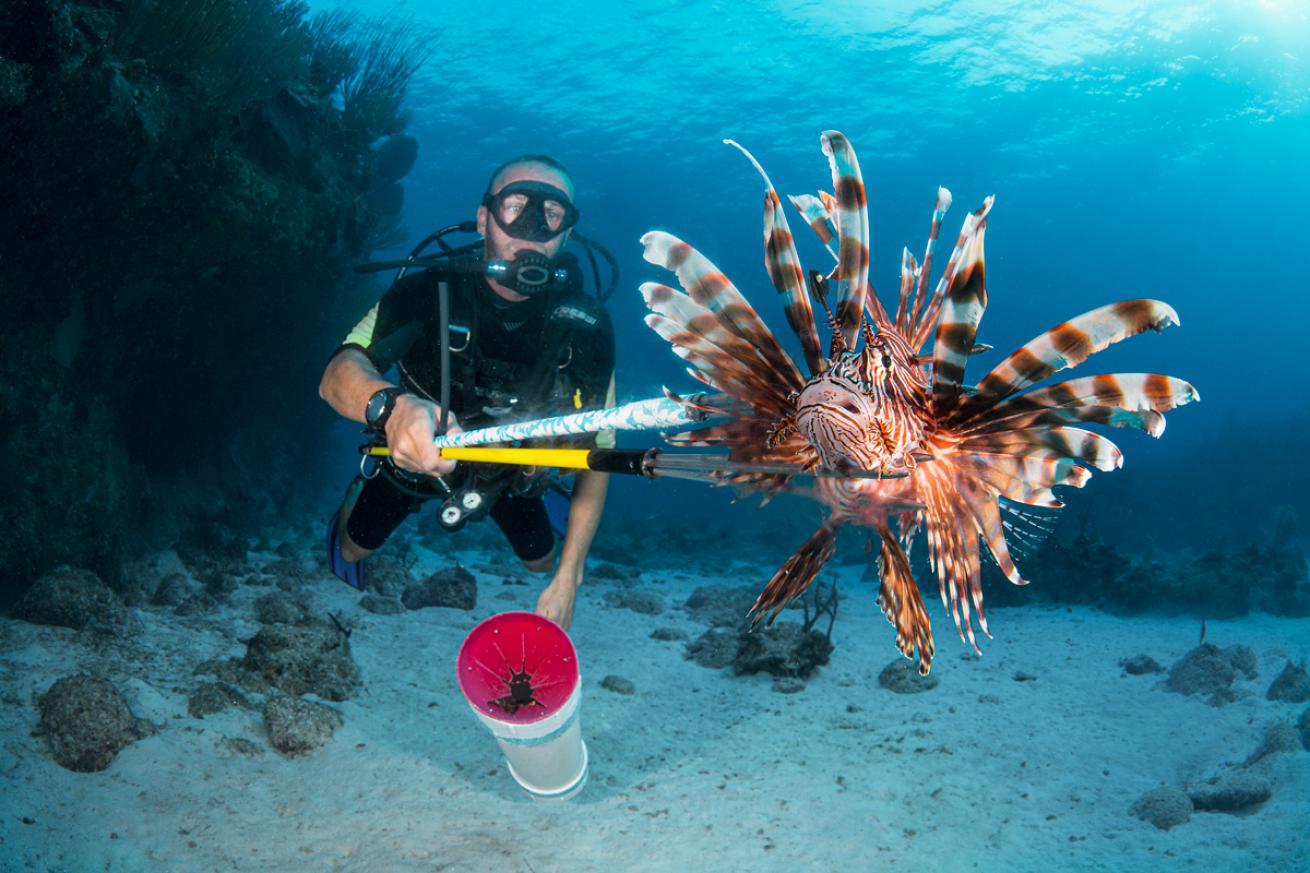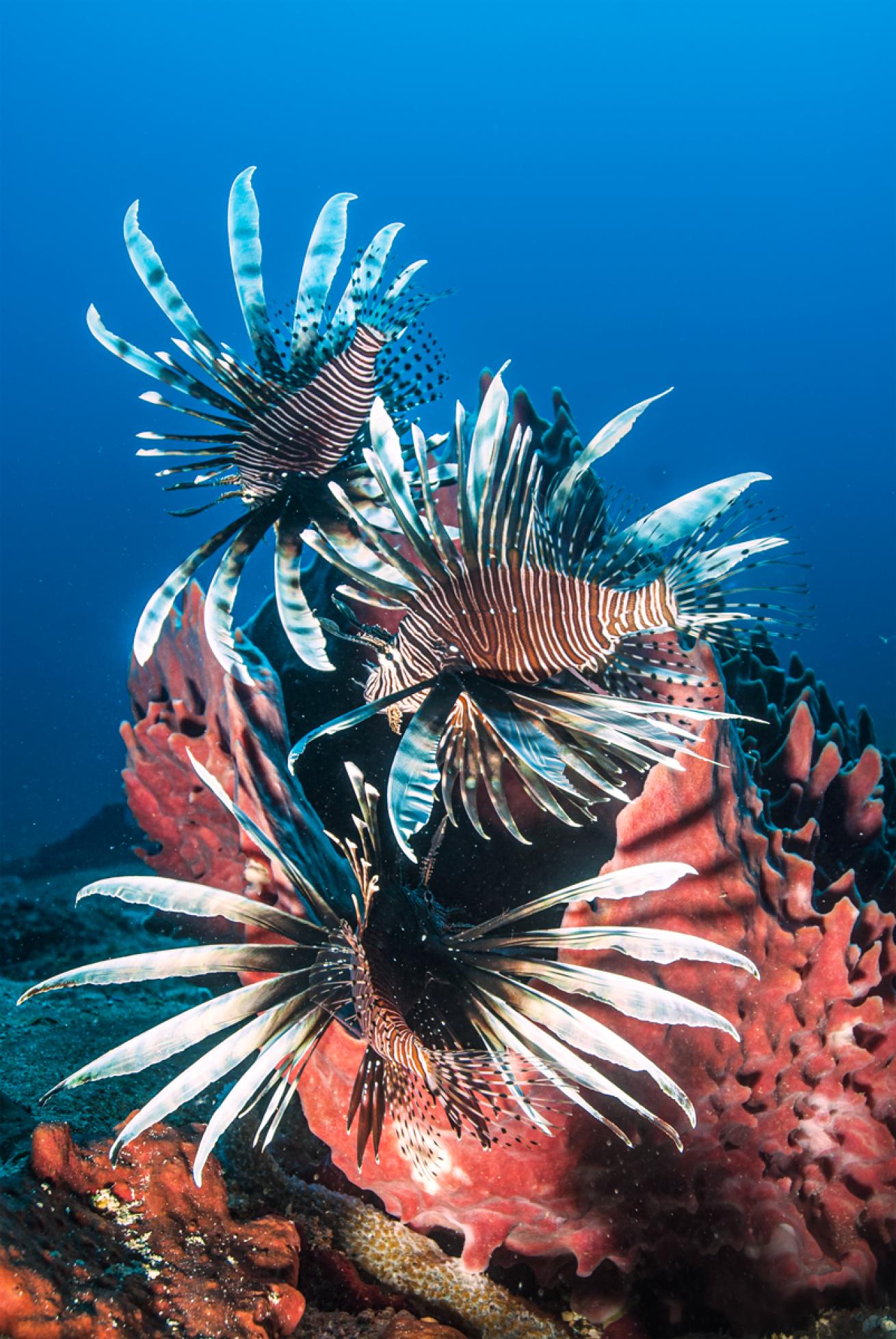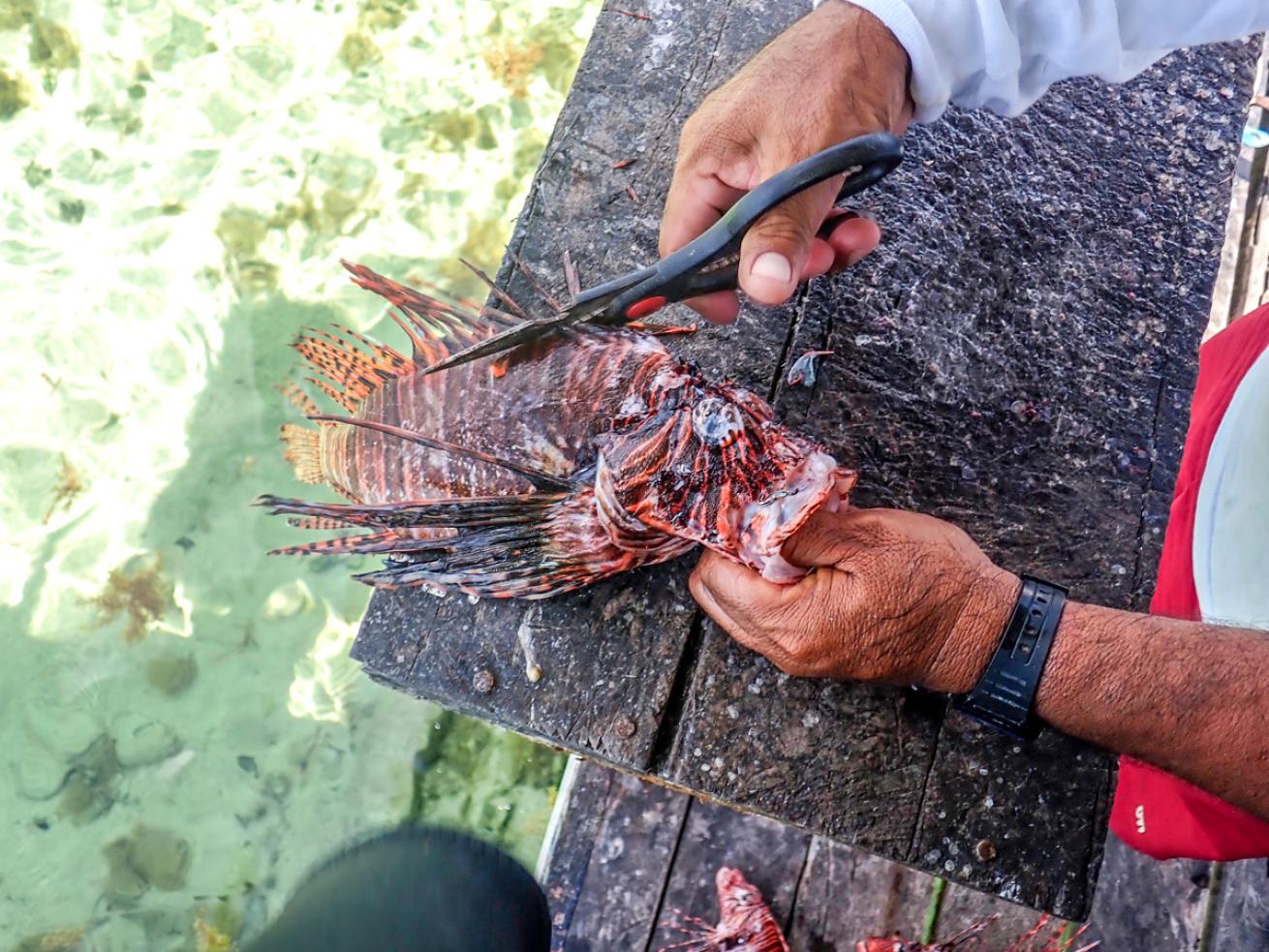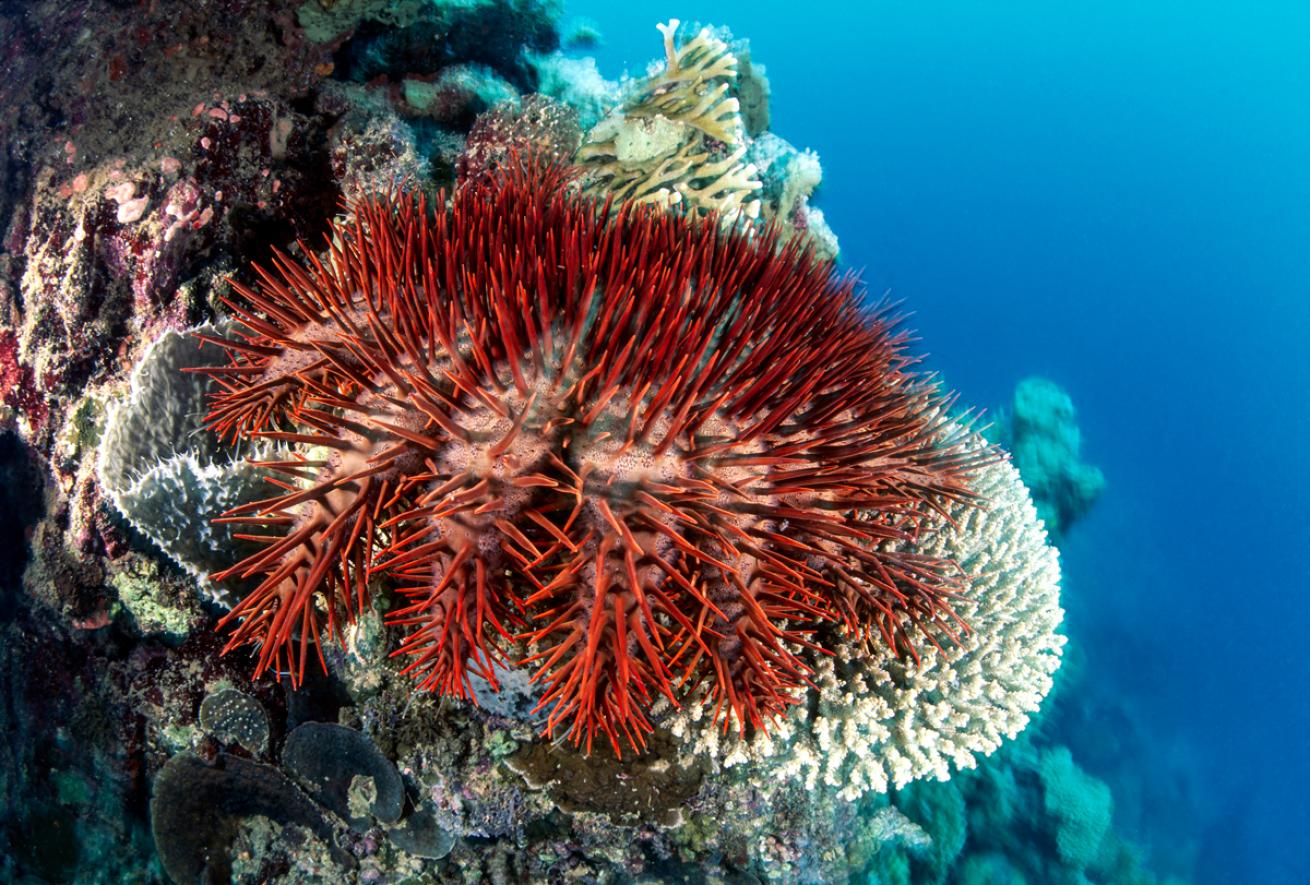Fences and Electric-Shock Robots: The New Tech of the Caribbean's Lionfish Battle

Courtesy Nino HalmA diver uses a specialized technique to spear a lionfish.
In the mid-1980s, the lionfish found its way to the Caribbean Sea, over 3,000 miles from its home in the Indian and Pacific oceans. In theory, the lionfish invasion was catalyzed by an accidental release from a saltwater aquarium, but scientists suspect the lionfish may have actually been “introduced” to the Caribbean more than once. In the decades that followed, the lionfish rapidly took over coral reef ecosystems in the Western Atlantic.
The lionfish has a number of key characteristics that make it far more successful in the Atlantic than it could ever be in its native oceans. For one, the lionfish looks so different from native Caribbean reef fish that common reef predators, such as groupers, do not recognize the lionfish as prey, a phenomenon scientists call “predator naivete.” It doesn’t help that the lionfish is equipped with venomous spines and colorful warning stripes too. It is also impressively efficient at reproduction. Once a lionfish reaches maturity, which typically takes about a year, the fish can spawn every few days, releasing an estimated 2 million eggs annually. Worst of all is its insatiable appetite. The exotic fish will happily consume just about anything it can find, even as its gut becomes packed full.
As populations of the voracious invader continue to grow, native fish populations have suffered. Studies in the Bahamas and the Gulf of Mexico have found lionfish can cause native fish populations to decline by 45 to 90 percent or more. It is known to prey on juvenile fish in particular, preventing these fish from becoming adult reef-dwellers and upsetting coral reef ecosystems. Indirectly, the loss of herbivorous native fish has allowed algae to overtake the reefs, reducing the amount of hard-coral habitat.
Efforts to fend off the invasion began in about the mid-2000s, when lionfish populations exploded across the Caribbean. By 2010, there were enough lionfish to warrant multiple fishing derbies per year across Florida and the Caribbean, rewarding participants based on the number of lionfish they catch. Now, over a decade later, derbies continue to be a primary means of managing the problem.

Courtesy FoodFramesInvasive lionfish are not recognized by predators as food—a phenomenon known as “predator naivete.”
Research shows ongoing efforts to cull lionfish give local ecosystems a much-needed reprieve. Unlike many other reef fish, lionfish are not susceptible to hook-and-line fishing. Instead, the most effective method of culling is scuba divers and freedivers using spearguns. However, this means culling efforts typically only remove lionfish living within relatively shallow waters. Meanwhile, studies show lionfish can persist up to 1,000 feet deep, well beyond the 130-foot limit for recreational divers. Scientists worry that lionfish out of reach of divers will rapidly reinvade shallow ecosystems over time.
To manage deeper populations of lionfish, scientists at the nonprofit Robots in Service of the Environment (RSE) developed an underwater robot that can stun lionfish using electric shocks and bring them back to the surface for the seafood market. The company hopes to develop a robot that’s both relatively inexpensive and highly efficient at catching lionfish throughout the animal’s depth range.
Fisheries managers at the National Oceanic and Atmospheric Administration are also studying how the lionfish’s natural affinity for congregating around underwater objects could be used to catch them without the need for divers.
The agency is currently testing a purse-net trap design that attracts lionfish using a simple lattice garden fence. While other native fish are also attracted to the fence structures, for the most part only the slow-moving, fearless lionfish stick around once the net is pulled up. The fence trap is still being piloted off the coast of Florida. Depending on the success of the trials currently underway, the traps may see more widespread use across the Western Atlantic.

Gerald NowakTo prepare the fish before cooking, you must carefully remove the venomous spines covering the fins with sharp scissors or a knife.
How Can You Help
Consistent culling of lionfish reduces the pressure they place on Caribbean coral reef ecosystems. Lionfish hunting also provides a unique opportunity for visiting divers to learn about spearfishing. Since lionfish are slowmoving, uniquely shaped fish that maneuver around coral reefs without much fear of divers, they are an excellent target for the novice spearfisher. Plus, they make a great meal topside! Many Caribbean dive shops offer the PADI Invasive Lionfish Tracker distinctive specialty, giving guests the opportunity to hunt for lionfish as part of the day’s adventure. Whether you’re an experienced spearfisher or looking to try a speargun for the first time, you can enjoy this facet of scuba diving while also helping the local coral-reef ecosystem.
More Ways To Get Involved
In addition to the PADI Invasive Lionfish Tracker distinctive specialty, you can help manage nuisance species in other parts of the world, such as the crown-of-thorns starfish and the purple urchin.
PADI Crown of Thorns Management Distinctive Specialty

Gary Bell oceanwideimages.comAn invasive crown-of-thorns starfish.
Around the Indo-Pacific region, a spiky, multiarmed sea star is wreaking havoc on the reefs. Several environmental factors, combined with floods of nutrients from human-caused runoff, have resulted in outbreaks that devastate hard corals. In healthy numbers, crown-of-thorns starfish, which are native to the region, help control fast-growing species and scavenge the unhealthy or dying, but too many of them leads to long-lasting and devastating effects on the reefs. This specialty course teaches divers background knowledge, monitoring methods and how to fight back with star-killing injectable vinegar.
PADI Kelp Restoration Distinctive Specialty
Kelp along California’s coastline has significantly decreased in the past decade. Purple urchins, native to the area, are mowing down the kelp due to massive die-offs of their main predator, the sunflower star. This specialty offered in California teaches divers about the factors influencing the loss of kelp, and then divers learn to safely and effectively remove urchins from the reef to give the kelp a fighting chance at regrowth.










